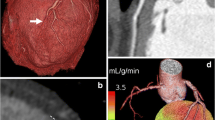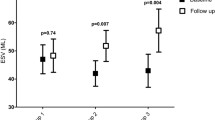Abstract
Background.In patients with extensive myocardial bridging, evaluation of its clinical significance remains a challenge.
Hypothesis.Sequential invasive testing is feasible and gives more insight into the pathophysiological mechanism of bridging-related angina.
Methods.Twelve patients with chest pain, proven ischaemia and extensive myocardial bridging were assessed. Myocardial bridging was evaluated at rest, during intracoronary acetylcholine infusion, through coronary flow velocity and flow reserve measurements, and during dobutamine stress.
Results.The mean length of the bridging segment was 24.9 mm (QCA; range 8.4-48.0 mm). Acetylcholine infusion caused severe vasospasm in two patients. In these two patients anginal symptoms were related to vasospasm and sequential testing was discontinued. In the remaining ten patients sequential testing was continued. Coronary flow reserve was normal in all patients: 3.3±0.6. In six patients reliable quantitative measurements could be performed during dobutamine stress. The mean systolic diameter of the bridging segment was 1.6±0.4 at baseline and 1.3±0.3 during dobutamine stress (mean of differences 0.38 (95% CI 0.1-0.7)). The difference between the diastolic and systolic diameter in the bridging segment increased from 0.3±0.2 mm at baseline to 1.0±0.5 mm during dobutamine infusion (mean of differences 0.6 (95% CI 0.3 to 0.9)).
Conclusion.Sequential testing for bridging is feasible and may disclose endothelial dysfunction or spasm as an underlying mechanism in a minority of patients. Coronary flow reserve was preserved. Dobutamine stress unmasked further lumen reduction and may give further insight into the clinical significance of myocardial bridging in individual patients. (Neth Heart J 2008;16:10-5.)


Similar content being viewed by others
References
Bourassa MG, Butnaru A, Lespérance J, Tardif JC. Symptomatic Myocardial Bridges: overview of Ischemic Mechanisms and Current Diagnostic and Treatment Stategies. J Am Coll Cardiol 2003; 41:351-9.
Ge J, Erbel R, Rupprecht HJ, Koch L, Kearney P, Gorge G, et al. Comparison of Intravasular Ultrasound and Angiography in the Assessment of Myocardial Bridging. Circulation 1994;89:1725-32.
Angelini P, Trivellato M, Donis J, Leachman RD. Myocardial Bridges: A Review. Prog Cardiovasc Dis 1983;26:75-88.
Ge J, Jeremias A, Rupp M, Abels M, Baumgart D, Liu F, et al. New signs characteristic of myocardial bridging demonstrated by intracoronary ultrasound and Doppler. Eur Heart J 1999;20:1707-16.
Möhlenkamp S, Hort W, Ge J, Erbel E. Update on Myocardial Bridging. Circulation 2002;106:2616-22.
Tio RA, Ebels T. Ventricular Septal Rupture Caused by Myocardial Bridging. Ann Thorax Surg 2001;72:1369-70.
Tio RA, Van Gelder IC, Boonstra PW, Crijns HGJM. Myocardial bridging in a survivor of sudden cardiac near-death?: Role of intracoronary Doppler flow measurements and angiography during dobutamine stress in the clinical evaluation. Heart 1997;77:280-2.
Haager PK, Schwarz ER, Vom Dahl J, Klues HG, Reffelmann T, Hanrath P. Long term angiographic and clinical follow up in patients with stent implantation for symptomatic myocardial bridging. Heart 2000;84:403-8.
Murase Y, Yamada Y, Hirashiki A, Ichihara S, Kanda H, Watarai M, et al. Genetic risk and gene-environment interaction in coronary artery spasm in Japanese men and women. Eur Heart J 2004;25:970-7.
Teragawa H, Fukuda Y, Matsuda K, Hirao H, Higashi Y, Yamagata T, et al. Myocardial bridging increases the risk of coronary spasm. Clin Cardiol 2003;26:377-83.
Hongo Y, Tada H, Ito K, Yasumura Y, Miyatake K, Yamagishi M. Augmentation of vessel squeezing at coronary-myocardial bridge by nitroglycerin: study by quantitative coronary angiography and intravascular ultrasound. Am Heart J 1999;138:345-50.
Klues HG, Schwarz ER, Vom Dahl J. Disturbed Intracoronary Hemodynamics in Myocardial Bridging, Early Normalization by Intracoronary Stent Placement. Circulation 1997;96:2905-13.
Schwarz ER, Klues HG, Vom Dahl J, Klein I, Krebs W, Hanrath P. Functional, Angiographic and Intracoronary Doppler Flow Characteristics in Symptomatic Patients With Myocardial Bridging: Effect of Short-Term Intravenous Beta-Blocker Medication. J Am Coll Cardiol 1996;27:1637-45.
Schwarz ER, Klues HG, vom Dahl J, Klein I, Krebs W, Hanrath P. Functional characteristics of myocardial bridging. A combined angiographic and intracoronary Doppler flow study. Eur Heart J 1997;18:434-42.
Uren NG, Crake T. Resistive vessel function in coronary artery disease. Heart 1996;76:299-304.
Escaned J, Cortes J, Flores A, Goicolea J, Alfonso F, Hernandez R, et al. Importance of diastolic fractional flow reserve and dobutamine challenge in physiologic assessment of myocardial bridging. J Am Coll Cardiol 2003;42:226-33.
Ng E, Jilaihawi H, Gershlick AH. Symptomatic myocardial bridging-a niche indication for drug-eluting stents? Int J Cardiol 2005;99:463-4.
Author information
Authors and Affiliations
Additional information
Department of Cardiology, Groningen University Medical Centre Groningen, University of Groningen, Groningen, the Netherlands
Correspondence to: R.A. Tio Department of Cardiology, Thoraxcentre, University Medical Centre Groningen, University of Groningen, PO Box 30.001, 9700 RB Groningen, the Netherlands
Rights and permissions
About this article
Cite this article
Hazenberg, A.J.C., Jessurun, G.A.J. & Tio, R.A. Mechanisms involved in symptomatic myocardial bridging. NHJL 16, 10–15 (2008). https://doi.org/10.1007/BF03086110
Issue Date:
DOI: https://doi.org/10.1007/BF03086110




